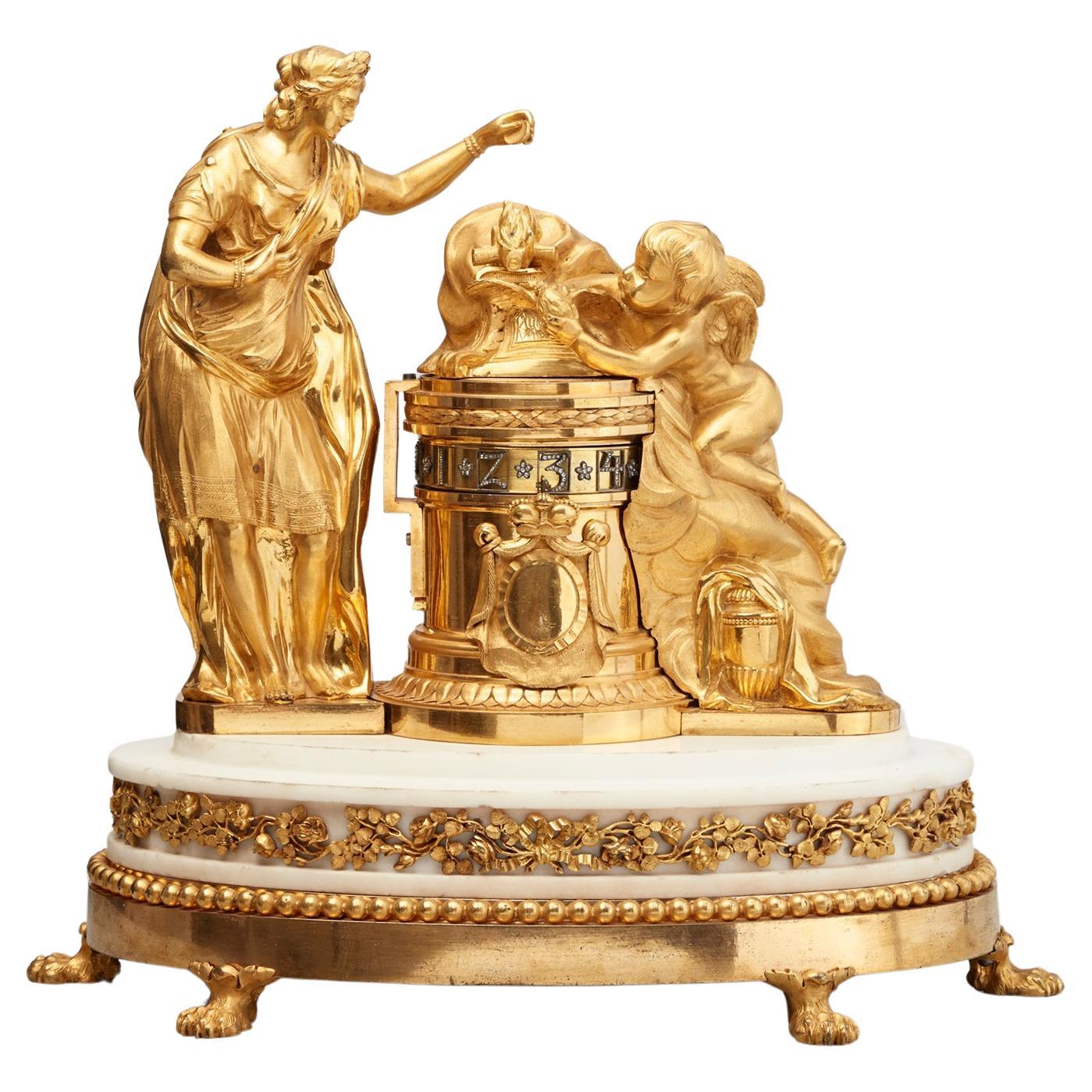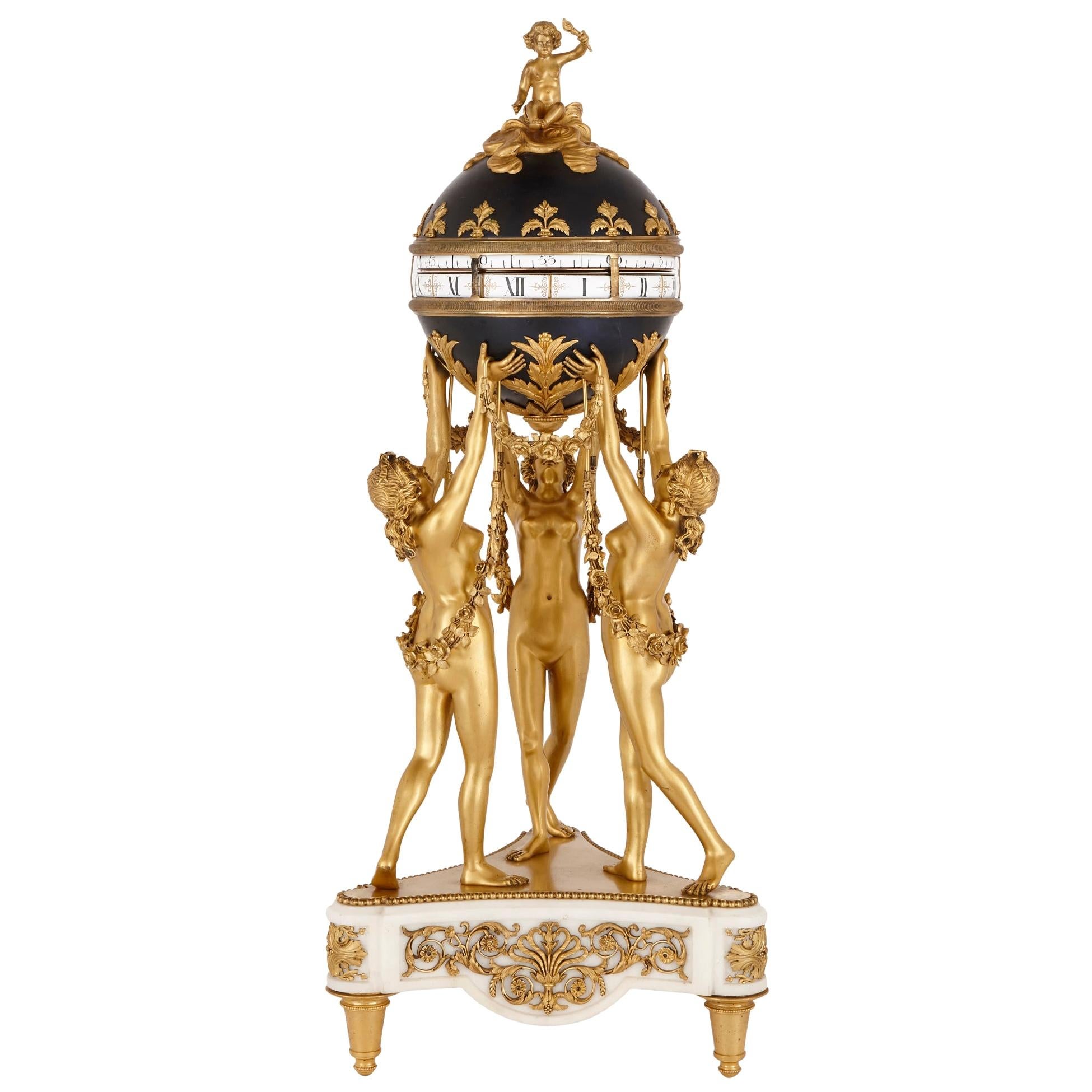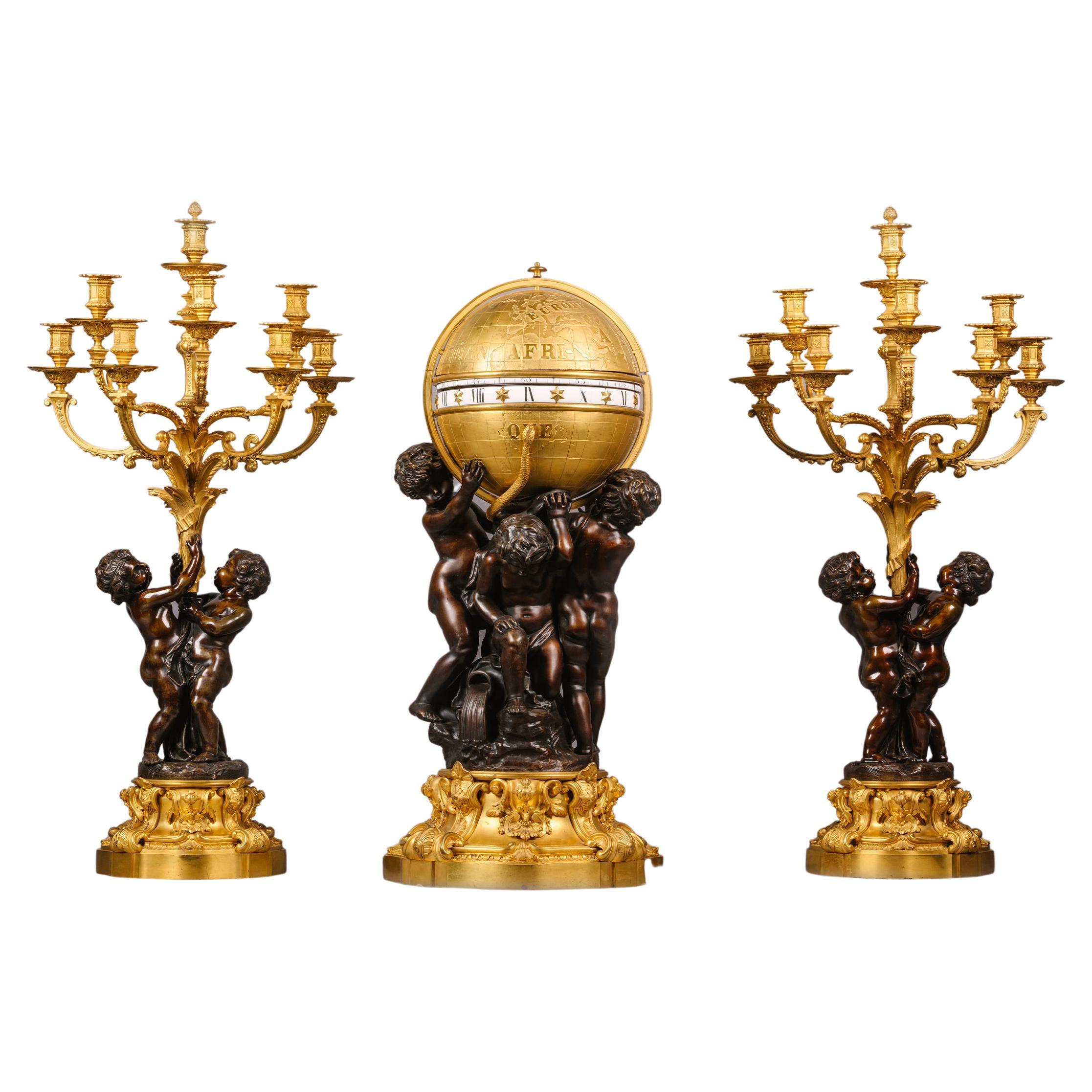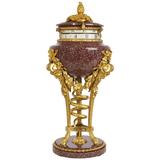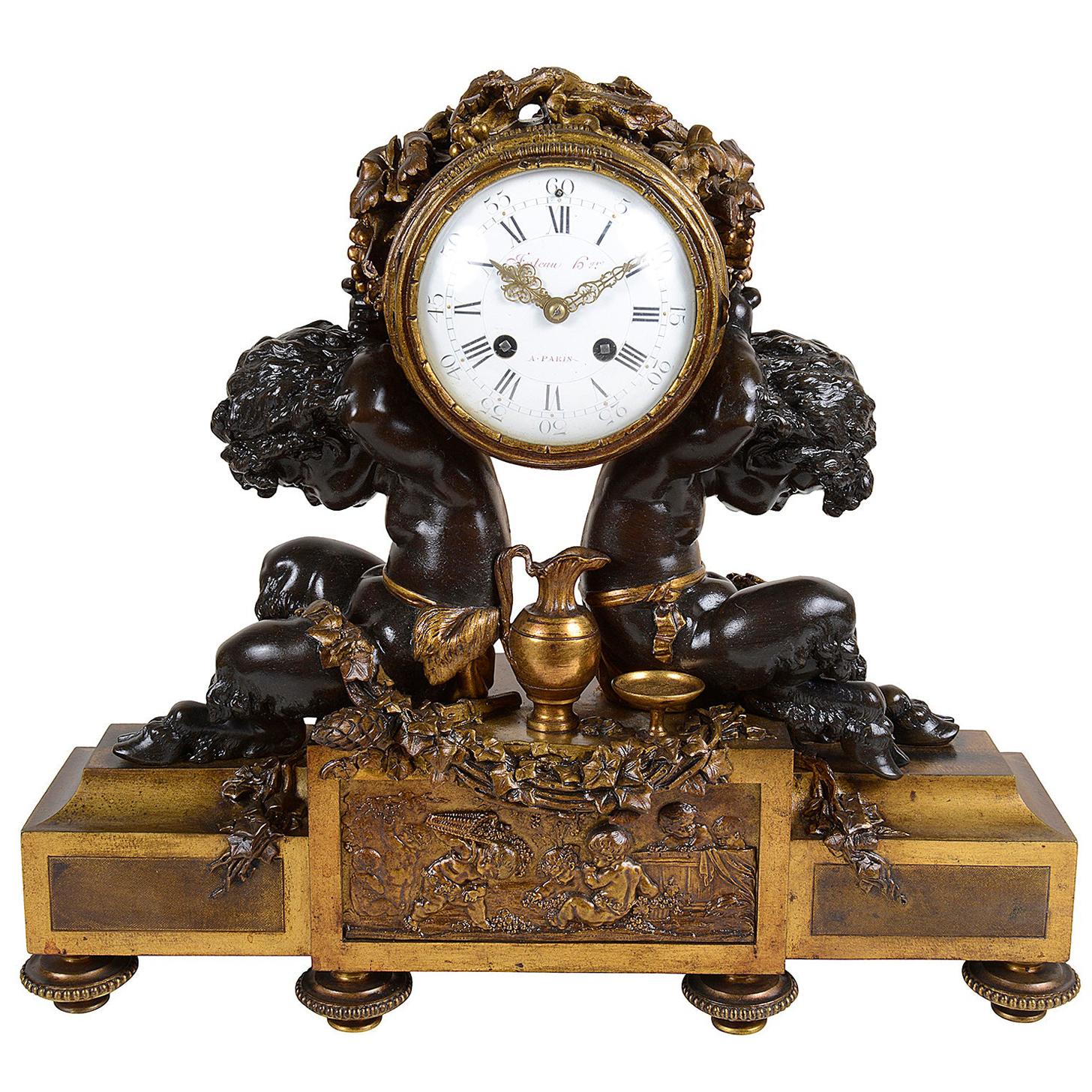Items Similar to “Cercles Tournants” Louis XVI Mantel Clock, Bronze Attributed to Gouthière
Want more images or videos?
Request additional images or videos from the seller
1 of 11
“Cercles Tournants” Louis XVI Mantel Clock, Bronze Attributed to Gouthière
About the Item
Important white marble “Cercles Tournants” mantel clock.
Gilt bronze mounts attributed to Pierre Gouthière.
Paris, Louis XVI period, circa 1775-1785.
Measures: Height 39.5cm; width including handles 21 cm; base 11.5 cm x 11.5 cm.
Two superposed dials, or “cercles tournants,” made up of enamel cartouches, indicate respectively the hours in Roman numerals and the minutes in Arabic numerals. The movement is housed in a Fine white statuary marble vase after the antique, sculpted with wide leaves and spiralling gadroons. The grooved squared handles feature lion masks; the belly is adorned with laurel leaf and seed garlands with a snake that indicates the time with its tongue. The clock is surmounted by a leaf and seed finial. The moulded pedestal is decorated with a beribboned laurel leaf and seed torus and rests on a square base, which itself is supported by a quadrangular gilt bronze base with plain reserves and matted borders.
Toward the mid 18th century, there was a revolution in the ornamentation employed in the Parisian decorative arts. Inspired by the archaeological discoveries made at Pompeii and Herculaneum, connoisseurs, artists and artisans progressively adopted the new style known as Neoclassicism. In the field of horology, this resulted in the creation of a new type of clock known as “cercles tournants.” The cercles tournants clock was better suited to cases shaped as vases “after the antique.” This new fashion was much appreciated by important collectors and reached its apogee during the reign of Louis XVI. The present clock is unusual in its juxtaposition of white marble and gilt bronze mounts, whereas nearly all the other known examples are made entirely of gilt bronze. The finely executed mounts may be attributed to the chaser Pierre Gouthière. Only a few similar examples employing the same materials are known. One of these was sold at auction at Christie’s, London on April 6, 1978, lot 14; a second example featuring ram’s heads and a lid decorated with a sculpted putto, formerly in the collection of the Count Greffulhe, was sold in London (Sotheby’s, July 23, 1937, lot 38).
Pierre Gouthière (1732-1813) was no doubt the most talented Parisian chaser of his time. He boasted, among his patrons, the Duke d’Aumont, one of the most important collectors of the second half of the 18th century. In 1767 Gouthière was named doreur ordinaire des Menus Plaisirs du Roi. The Menus Plaisirs was responsible for the commissions given by the King to various artists and artisans. The nomination greatly enhanced his reputation and won him a clientele of connoisseurs of rare and precious objects, including the royal family, the duc d’Aumont, important aristocrats such as the Marquis of Marigny, brother of the Marquise de Pompadour, Princess Kinsky, the King’s mistress Countess du Barry, the Duchess of Mazarin, the Duke of Duras, the Duchess of Villeroy, and well-known financiers such as the wealthy treasurer of the Marine, Baudard de Saint-James, and the influential banker Thélusson.
- Attributed to:Pierre Gouthiere (Cabinetmaker)
- Dimensions:Height: 15.56 in (39.5 cm)Diameter: 8.27 in (21 cm)
- Style:Louis XVI (Of the Period)
- Materials and Techniques:
- Place of Origin:
- Period:1770-1779
- Date of Manufacture:circa 1775-1785
- Condition:Wear consistent with age and use. Certificate of authenticity. Original gilding and movement Fully overhauled upon sale.
- Seller Location:Paris, FR
- Reference Number:
About the Seller
No Reviews Yet
Vetted Seller
These experienced sellers undergo a comprehensive evaluation by our team of in-house experts.
1stDibs seller since 2015
- ShippingRetrieving quote...Ships From: Paris, France
- Return PolicyThis item cannot be returned.
More From This SellerView All
- Sèvres Porcelain Louis XVI Lyre Mantel Clock by Kinable, Dial by DubuissonBy Dubuisson, Dieudonné KinableLocated in Paris, FRDieudonné Kinable Enamel Dial Attributed to Dubuisson (1731-1815) Exceptional Porcelain Lyre Mantel Clock from the Royal Sèvres Porcelain Manufactory Paris, late Louis XVI period, circa 1785-1790 Height 62 cm; width 26 cm; depth 16 cm The round enamel dial, signed “Kinable”, indicates the hours in Roman numerals, the fifteen-minute intervals in Arabic numerals, the annual calendar and the signs of the Zodiac, by means of four hands, two of which are made of pierced gilt bronze, the two others in blued steel. The magnificent lyre-shaped case is made of “bleu nouveau” Sèvres porcelain and finely chased and gilt bronze. The bezel is made up of a gilt bronze twisted rope; the pendulum is adorned with brilliant-cut paste stones; the body of the lyre is adorned with gilt bronze beading and with laurel leaf and seed motifs, with two rosettes issuing floral and foliate swags. The clock is surmounted by a mask with radiating sunrays. The spreading foot is decorated with beading and twisted rope motifs and a leafy garland. The en-suite decorated oval base is raised upon four flattened ball feet. The Royal Sèvres Porcelain Factory produced the lyre clock model as of 1785. Four colours were offered: turquoise, green, pink and bleu nouveau. These exceptional clocks were made for the connoisseurs of the time. Louis XVI had a similar clock in his Salon des jeux in Versailles; its dial bore the signature of the clockmaker Courieult (this is almost certainly the example illustrated in P. Verlet, Les bronzes dorés français du XVIIIe siècle, Paris, 1999, p. 41). Kinable, however, was the clockmaker who purchased the greatest number of lyre cases from the factory, and he developed the model in the late 18th century. Among the porcelain lyre clocks signed by this brilliant horologer, one example is in the Victoria & Albert Museum in London (illustrated in H. Ottomeyer and P. Pröschel, Vergoldete Bronzen, Band I, Munich, 1986, p. 252, fig. 4.6.26). A second such clock is in the Royal British Collection (see C. Jagger, Royal Clocks, The British Monarchy & its Timekeepers 1300-1900, 1983, p. 130, fig. 176). Bibliography: M. Gay and A. Lemaire, “Les pendules lyre”, in Bulletin de l’Association nationale des Collectionneurs et Amateurs d’Horlogerie ancienne, Winter 1993, n° 68, p. 5-40. Dieudonné Kinable (active circa 1785-1810) One of the most important Parisian clockmakers of the late 18th century. His shop was located at n° 131 Palais Royal. He purchased a great number of lyre-type porcelain clock cases...Category
Antique 1780s French Louis XVI Mantel Clocks
MaterialsBronze
- Chased Gilt Bronze Rocaille Louis XV Cartel by Viger, Case Attributed to OsmondBy François VigerLocated in Paris, FRFrançois Viger, reçu maître horloger reçu maître en 1744 Case Attributed to Robert Osmond (1711-1789), reçu maître fondeur en janvier 1746 Im...Category
Antique 1750s French Louis XV Wall Clocks
MaterialsBronze
- Pair of Sèvres Bisque Porcelain Winged Lions Bearing Gilt BasketsBy Alexandre-Évariste Fragonard 1Located in Paris, FRAfter a Model by Alexandre-Evariste Fragonard Rare Pair of Sèvres Bisque Porcelain Winged Lions Bearing Gilt Baskets Sèvres Royal Manufactory, Restoration period, circa 1...Category
Antique 1820s French Restauration Decorative Baskets
MaterialsPorcelain, Sèvres
You May Also Like
- French Louis XVI 'cercle a tournant' clockLocated in HAARLEM, NLVery unusual and important finely chased and gilt French Pendule ’Cercle a tournant’. Louis XVI circa 1780. This ‘Cercle a tournant’ clock symbolising THE ALTAR OF VENUS . The revolving dial indicates hours in Arabic numbers alternated with finely cut and assembled paste rosettes. Mounted in a tuncated column decorated with a ribbon-tied laurel torus, a leaf frieze and a shield whose medallion at one bore engraved initials surmounted by a German Prince’s crown...Category
Antique 18th Century Mantel Clocks
MaterialsMarble, Bronze
- Ormolu, White Marble and Tole Cercle Tournant Mantel Clock by LepauteBy Lepaute, Francois VionLocated in London, GBThis exceptional mantel clock was created in the early 20th century in France, inspired by an 18th century model by the famous metalworker, François Vion (French, 1737-1790). The clock’s design includes sculptures of the Three Graces holding up a spherical clock with a revolving, or ‘cercle tournant...Category
Early 20th Century French Louis XVI Mantel Clocks
MaterialsMarble, Bronze, Ormolu, Tôle
- Cercles Tournants Clock Garniture by Deniere, ParisBy Jean-François DenièreLocated in Brighton, West SussexA Rare and Exceptional Gilt and Patinated Bronze Monumental Cercles Tournants Clock Garniture, by Deniere, Paris. The backplate signed 'DENIERE...Category
Antique 19th Century French Louis XVI Mantel Clocks
MaterialsBronze
- Neoclassical Style Ormolu and Porphyry Cercle Tournant Fine French Mantel ClockLocated in London, GBThis stunning antique mantel clock is unusual for its serpentine design, featuring a gilt bronze, hanging snake head that acts as a clock hand. The 360 degree turning circular ena...Category
Antique 19th Century French Neoclassical Mantel Clocks
MaterialsPorphyry, Bronze
- French Louis XVI Style Bronze Mantel ClockLocated in Brighton, SussexA very good quality 19th century French gilded ormolu and bronze Louis XVI style mantel (fireplace) clock, have cloven hoofed putti supporting the clock, with Bacchus influenced deco...Category
Antique 19th Century French Louis XVI Mantel Clocks
MaterialsBronze, Ormolu
- Louis XVI Style Gilt Bronze Mantel ClockLocated in Bradenton, FLA very good quality Louis XVI Style Gilt Bronze Mantel Clock. French gilt bronze clock with enamel face, fruit and lion motif, on plinth. H 22.3 cm (8.8 in.), All clocks sold as is w...Category
Antique 19th Century French Louis XVI Mantel Clocks
MaterialsBronze
Recently Viewed
View AllMore Ways To Browse
6 Hour Clocks
Rare Clock Antique Clocks
Brown Bronze Clock
Pierre Royal
Antique Furniture Mantel Clocks
King Louis Xvi Furniture
Louis Xvi King
Important Clocks
Square Clock
Louis Mantel Clock Bronze
Bronze Enamel Gilt Mantel Clock
King Louis Xvi Of France
6 Louis Xvi
Paris Bronze Mantel Clocks
Bronze And Marble Mantel Clock
Bronze Marble Mantel Clocks
Louis Xvi Bronze Clock
Louis Xvi Gilt Clock
